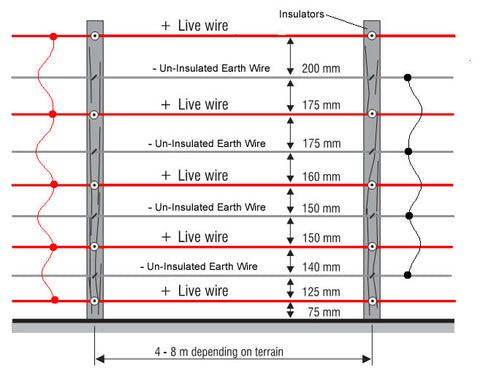You have no items in your shopping cart.
Dry Soil restricts the conductivity of the ground.
All energisers provide a pulse of energy that originates from their 'hot' terminal then travels down the fence line on a charged or 'hot' wire. Most users understand this aspect of electric fencing. It's fairly obvious that the hot wires can't be touching a steel post or laying on the soil surface. What's not so obvious is that in the instant when an animal comes into contact with that charged wire, its body contains that energy but is not shocked… yet!
In order to provide a shock and thus the respect for the fence, the energy must travel out of the animal's feet, through the soil, into the energiser's ground rods, then into the energiser's ground terminal. At that point, the circuit has been completed, and the animal receives the shock.
An electrical circuit of an Earth Return electric fence system is composed of three vectors;-
- 1/. The energy going out from the energiser along a live wire insulated from all other materials. This remains as an OPEN circuit until;-
- 2/. The animal touches the live wire and the ground AT THE SAME TIME. This then conveys the current from the live wire to the ground with the potential of giving the animal a shock as it does so then;-
- 3/. The current is then passed along the ground to the earth stake driven into the ground and so back to the energiser hence completing the circuit and the animal gets his shock.
All three of these situations must have the capacity to transfer current to the next phase of the circuit for the fence to work, as soon as one is broken - the fence is broken and the animal will not feel a shock despite touching an active live wire.
Electric Fences constructed in the UK and other permanently moist climates rarely suffer from problems of poor conductivity through the soil. Although we all talk about the "ground" conducting the electricity - this is not actually the case as it is the WATER held around the soil particles that is actually carrying the electricity. Dry soil will still carry some current but not nearly as well as moist soil.
As the soil moisture becomes less (and grass becomes brown) the resistance in the soil increases (from 50 ohms to 500 ohms to 5000 ohms to 10,000 ohms) and much less energy passes through the animal. When absolutely NO soil moisture is present (This rarely happens) the soil has become an insulator instead of a conductor. The pulse’s path is blocked and the animal feels nothing.
For this reason, this "English" type of Earth Return electric fence is not suitable for all dry countries. An all-hot electric fence relies totally on adequate soil moisture to complete the circuit between the animal and the energiser's ground system and this will not work in a dry climate.
What can we do? Fortunately, there is an alternative design to use in the arid areas. Take the Earth system right out of the equation. Connect the energiser's ground terminal to the ground rods, and then connect the ground rods to a second wire in the fence line, making it a ground wire. We call this a "Fence Return" electric fence.
As the animal attempts to penetrate the fence, it bridges the gap between the 'hot' and 'ground' wires and receives a shock. The electron flow is routed back to the energiser via a conductive wire, not blocked by dry soil. This shock is far more effective than one from a poorly grounded all-hot system!


Schematic diagram of an Earth Return Fence.
Construction of the fence is by simply adding an extra line into the fence below the primary live wire (this is always aimed at the targets nose height.) This earth line should not be insulated from the posts in the manner that the live wire MUST be insulated. It does not matter if it is connected to the ground as you will be connecting it to the earth posts anyway - save some money. A second line may be inserted below the earth wire so that the wires alternate up the post ( Live-earth-live) How many wires you use is at your discretion and depends on the target animals.
The live wires are connected to the Live terminal on the energiser in the normal way. The earth wire is connected first to the earth stake and then to the earth terminal on the energiser. The diagrams give a good idea of how to construct the fence.
Alternating Hot/Earth Elephant fence. Zambia, Africa









← Older Post Newer Post →
0 comments